Analysis of Social Determinants Impacting Cardiovascular Health Report
VerifiedAdded on 2021/04/17
|8
|1338
|59
Report
AI Summary
This report examines the social determinants of health and their impact on cardiovascular diseases, focusing on the Australian context. It highlights how factors like income inequality, educational disparities, access to health services, social support networks, physical environment, gender, and ethnicity contribute to health inequalities and increase the risk of cardiovascular diseases. The report explores the correlations between these social determinants and the prevalence of cardiovascular diseases, emphasizing the disproportionate impact on vulnerable communities. It also touches upon the discrimination faced by marginalized groups in accessing healthcare and the role of environmental factors. The conclusion stresses the intricate relationship between socio-economic factors and the risk of acquiring cardiovascular diseases, advocating for the diagnosis, prevention, and cure of CVD to be inversely proportionate to the existing socio-economic-cultural disparities.
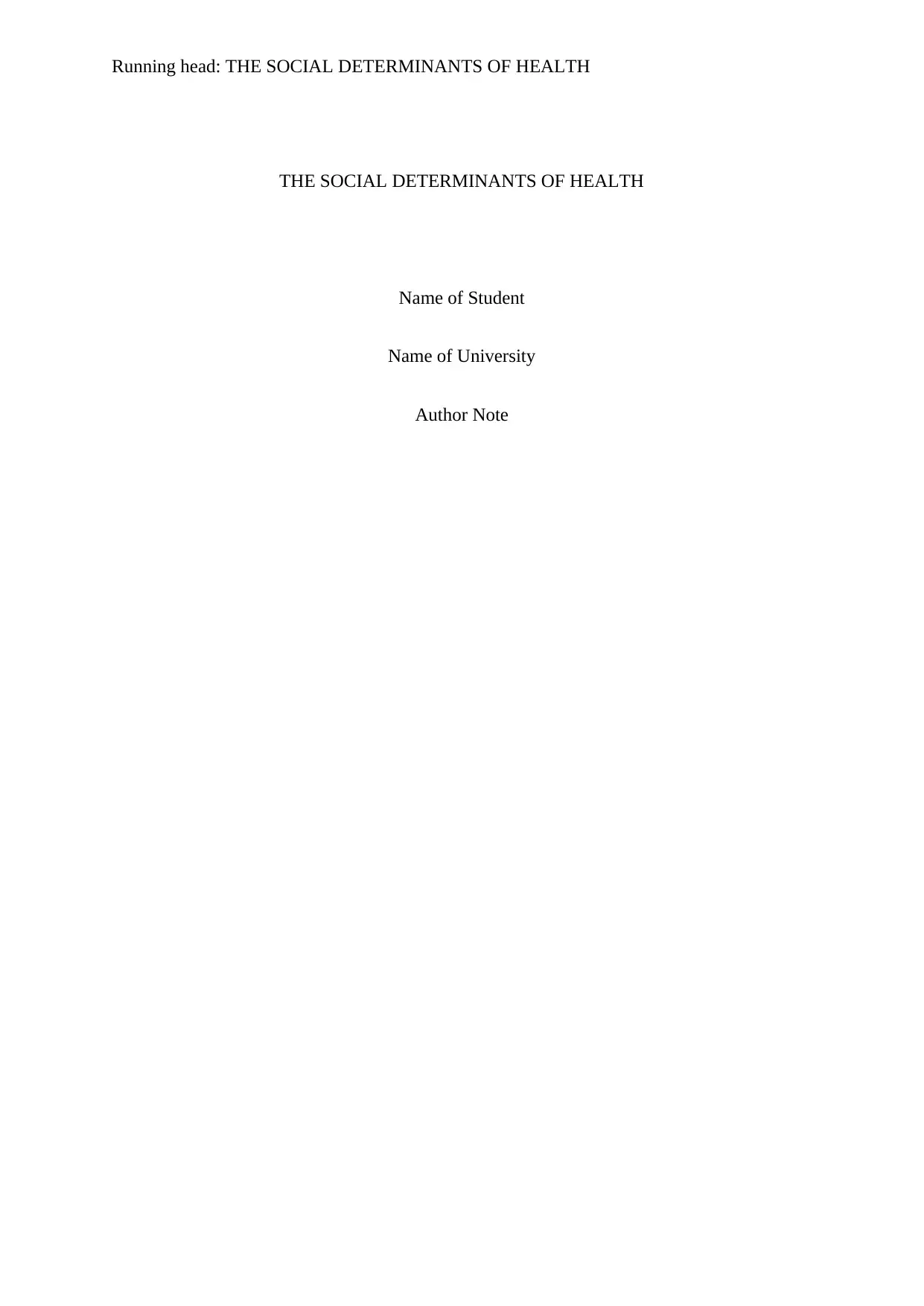
Running head: THE SOCIAL DETERMINANTS OF HEALTH
THE SOCIAL DETERMINANTS OF HEALTH
Name of Student
Name of University
Author Note
THE SOCIAL DETERMINANTS OF HEALTH
Name of Student
Name of University
Author Note
Paraphrase This Document
Need a fresh take? Get an instant paraphrase of this document with our AI Paraphraser
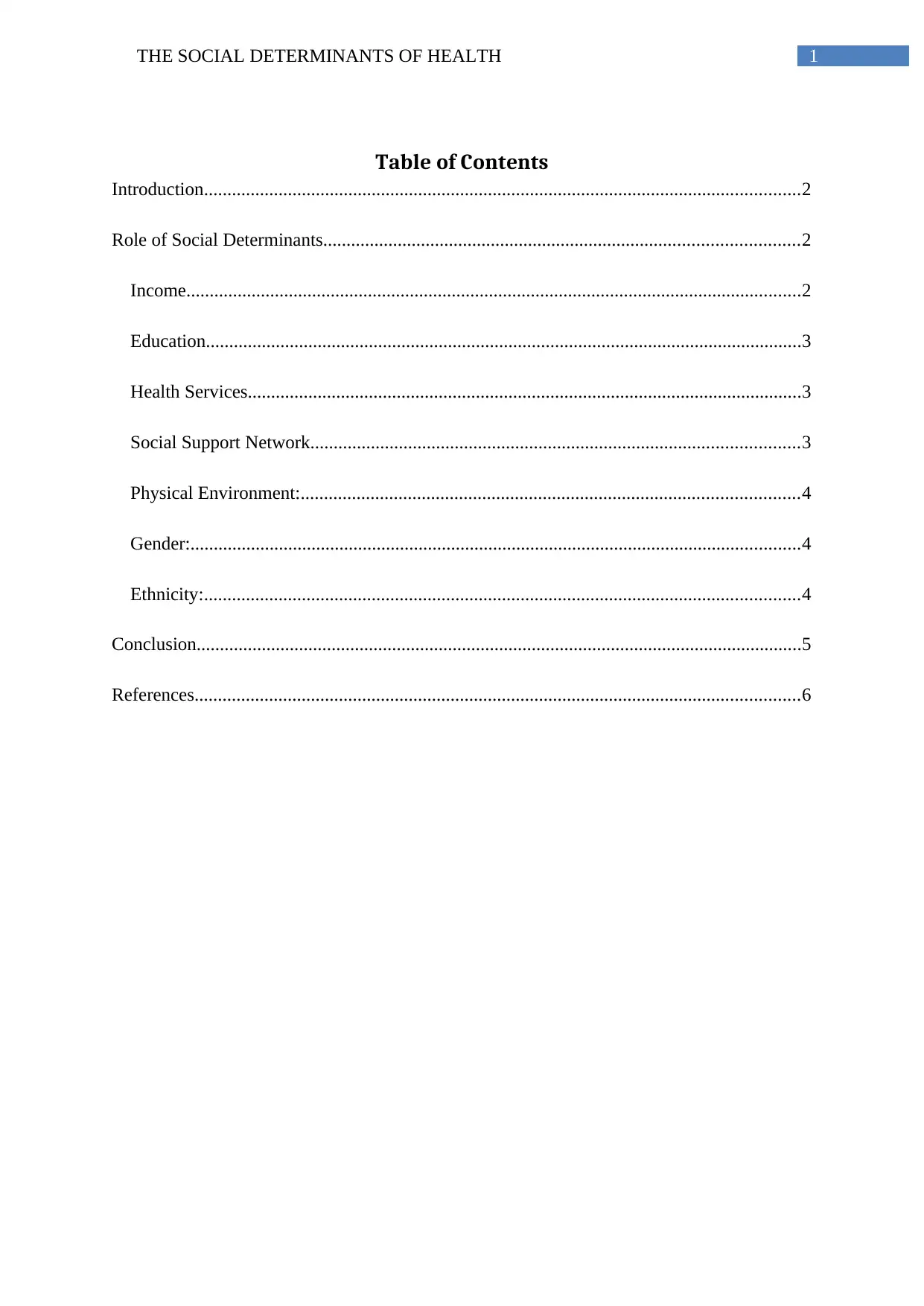
1THE SOCIAL DETERMINANTS OF HEALTH
Table of Contents
Introduction................................................................................................................................2
Role of Social Determinants......................................................................................................2
Income....................................................................................................................................2
Education................................................................................................................................3
Health Services.......................................................................................................................3
Social Support Network.........................................................................................................3
Physical Environment:...........................................................................................................4
Gender:...................................................................................................................................4
Ethnicity:................................................................................................................................4
Conclusion..................................................................................................................................5
References..................................................................................................................................6
Table of Contents
Introduction................................................................................................................................2
Role of Social Determinants......................................................................................................2
Income....................................................................................................................................2
Education................................................................................................................................3
Health Services.......................................................................................................................3
Social Support Network.........................................................................................................3
Physical Environment:...........................................................................................................4
Gender:...................................................................................................................................4
Ethnicity:................................................................................................................................4
Conclusion..................................................................................................................................5
References..................................................................................................................................6
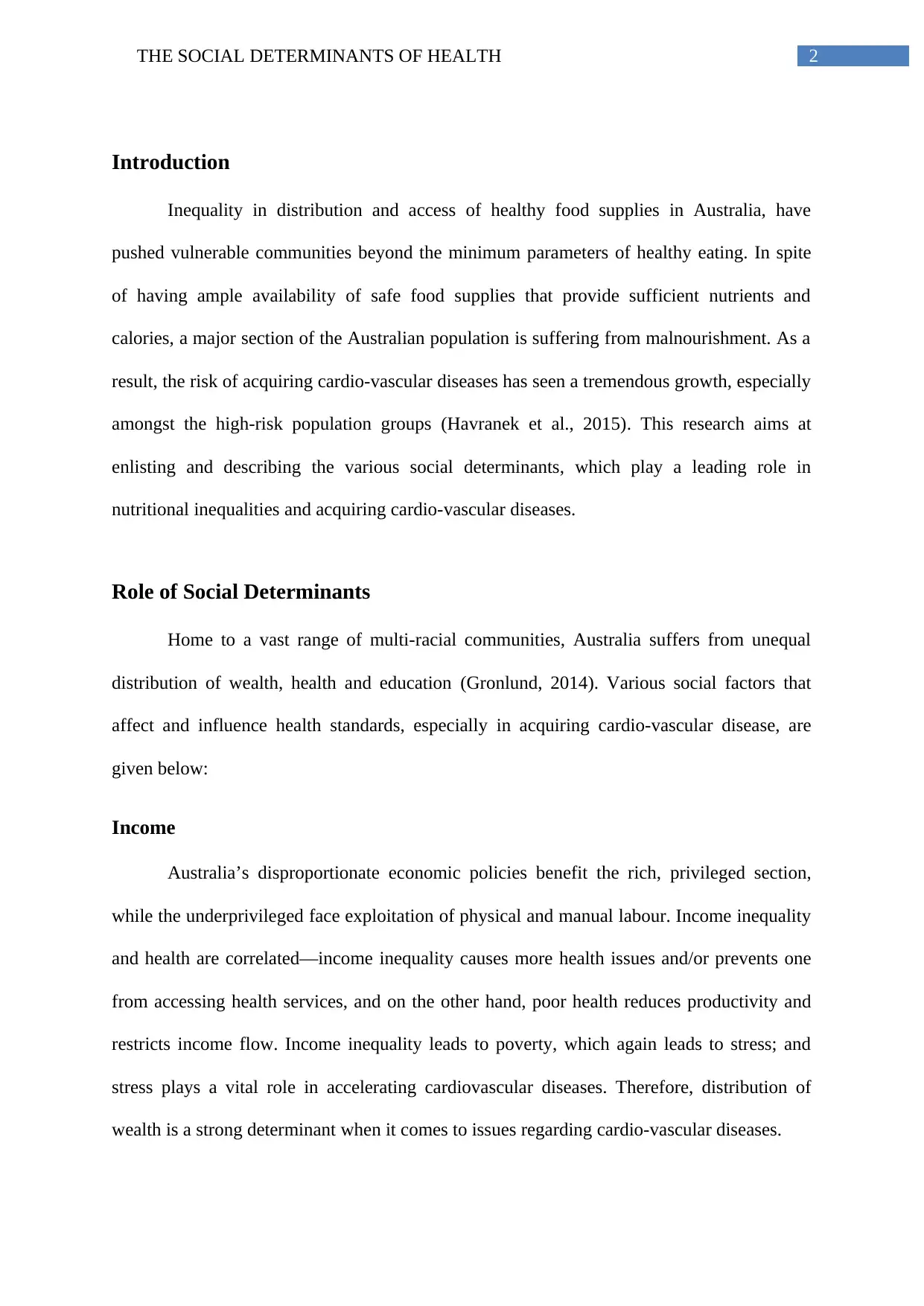
2THE SOCIAL DETERMINANTS OF HEALTH
Introduction
Inequality in distribution and access of healthy food supplies in Australia, have
pushed vulnerable communities beyond the minimum parameters of healthy eating. In spite
of having ample availability of safe food supplies that provide sufficient nutrients and
calories, a major section of the Australian population is suffering from malnourishment. As a
result, the risk of acquiring cardio-vascular diseases has seen a tremendous growth, especially
amongst the high-risk population groups (Havranek et al., 2015). This research aims at
enlisting and describing the various social determinants, which play a leading role in
nutritional inequalities and acquiring cardio-vascular diseases.
Role of Social Determinants
Home to a vast range of multi-racial communities, Australia suffers from unequal
distribution of wealth, health and education (Gronlund, 2014). Various social factors that
affect and influence health standards, especially in acquiring cardio-vascular disease, are
given below:
Income
Australia’s disproportionate economic policies benefit the rich, privileged section,
while the underprivileged face exploitation of physical and manual labour. Income inequality
and health are correlated—income inequality causes more health issues and/or prevents one
from accessing health services, and on the other hand, poor health reduces productivity and
restricts income flow. Income inequality leads to poverty, which again leads to stress; and
stress plays a vital role in accelerating cardiovascular diseases. Therefore, distribution of
wealth is a strong determinant when it comes to issues regarding cardio-vascular diseases.
Introduction
Inequality in distribution and access of healthy food supplies in Australia, have
pushed vulnerable communities beyond the minimum parameters of healthy eating. In spite
of having ample availability of safe food supplies that provide sufficient nutrients and
calories, a major section of the Australian population is suffering from malnourishment. As a
result, the risk of acquiring cardio-vascular diseases has seen a tremendous growth, especially
amongst the high-risk population groups (Havranek et al., 2015). This research aims at
enlisting and describing the various social determinants, which play a leading role in
nutritional inequalities and acquiring cardio-vascular diseases.
Role of Social Determinants
Home to a vast range of multi-racial communities, Australia suffers from unequal
distribution of wealth, health and education (Gronlund, 2014). Various social factors that
affect and influence health standards, especially in acquiring cardio-vascular disease, are
given below:
Income
Australia’s disproportionate economic policies benefit the rich, privileged section,
while the underprivileged face exploitation of physical and manual labour. Income inequality
and health are correlated—income inequality causes more health issues and/or prevents one
from accessing health services, and on the other hand, poor health reduces productivity and
restricts income flow. Income inequality leads to poverty, which again leads to stress; and
stress plays a vital role in accelerating cardiovascular diseases. Therefore, distribution of
wealth is a strong determinant when it comes to issues regarding cardio-vascular diseases.
⊘ This is a preview!⊘
Do you want full access?
Subscribe today to unlock all pages.

Trusted by 1+ million students worldwide
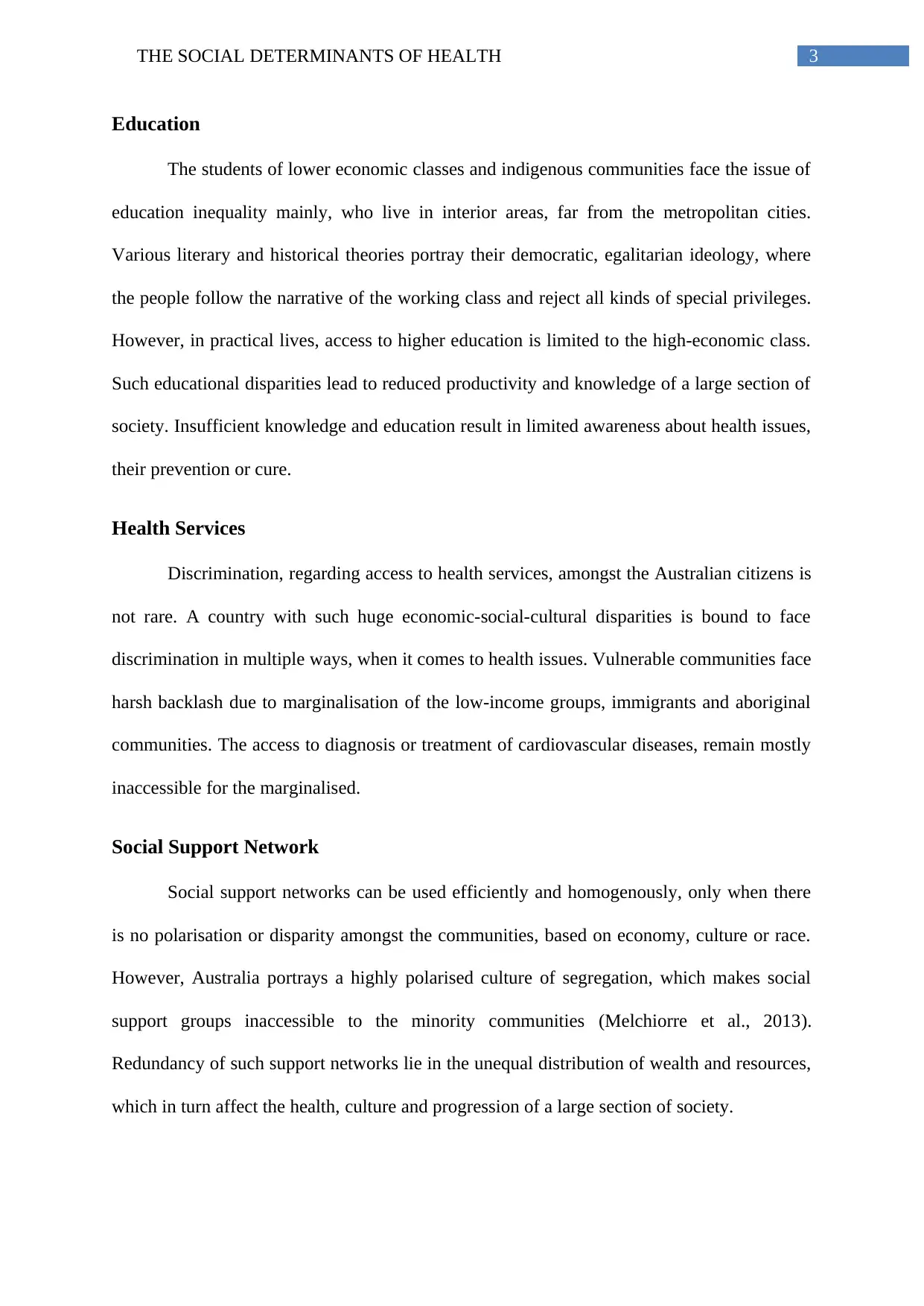
3THE SOCIAL DETERMINANTS OF HEALTH
Education
The students of lower economic classes and indigenous communities face the issue of
education inequality mainly, who live in interior areas, far from the metropolitan cities.
Various literary and historical theories portray their democratic, egalitarian ideology, where
the people follow the narrative of the working class and reject all kinds of special privileges.
However, in practical lives, access to higher education is limited to the high-economic class.
Such educational disparities lead to reduced productivity and knowledge of a large section of
society. Insufficient knowledge and education result in limited awareness about health issues,
their prevention or cure.
Health Services
Discrimination, regarding access to health services, amongst the Australian citizens is
not rare. A country with such huge economic-social-cultural disparities is bound to face
discrimination in multiple ways, when it comes to health issues. Vulnerable communities face
harsh backlash due to marginalisation of the low-income groups, immigrants and aboriginal
communities. The access to diagnosis or treatment of cardiovascular diseases, remain mostly
inaccessible for the marginalised.
Social Support Network
Social support networks can be used efficiently and homogenously, only when there
is no polarisation or disparity amongst the communities, based on economy, culture or race.
However, Australia portrays a highly polarised culture of segregation, which makes social
support groups inaccessible to the minority communities (Melchiorre et al., 2013).
Redundancy of such support networks lie in the unequal distribution of wealth and resources,
which in turn affect the health, culture and progression of a large section of society.
Education
The students of lower economic classes and indigenous communities face the issue of
education inequality mainly, who live in interior areas, far from the metropolitan cities.
Various literary and historical theories portray their democratic, egalitarian ideology, where
the people follow the narrative of the working class and reject all kinds of special privileges.
However, in practical lives, access to higher education is limited to the high-economic class.
Such educational disparities lead to reduced productivity and knowledge of a large section of
society. Insufficient knowledge and education result in limited awareness about health issues,
their prevention or cure.
Health Services
Discrimination, regarding access to health services, amongst the Australian citizens is
not rare. A country with such huge economic-social-cultural disparities is bound to face
discrimination in multiple ways, when it comes to health issues. Vulnerable communities face
harsh backlash due to marginalisation of the low-income groups, immigrants and aboriginal
communities. The access to diagnosis or treatment of cardiovascular diseases, remain mostly
inaccessible for the marginalised.
Social Support Network
Social support networks can be used efficiently and homogenously, only when there
is no polarisation or disparity amongst the communities, based on economy, culture or race.
However, Australia portrays a highly polarised culture of segregation, which makes social
support groups inaccessible to the minority communities (Melchiorre et al., 2013).
Redundancy of such support networks lie in the unequal distribution of wealth and resources,
which in turn affect the health, culture and progression of a large section of society.
Paraphrase This Document
Need a fresh take? Get an instant paraphrase of this document with our AI Paraphraser
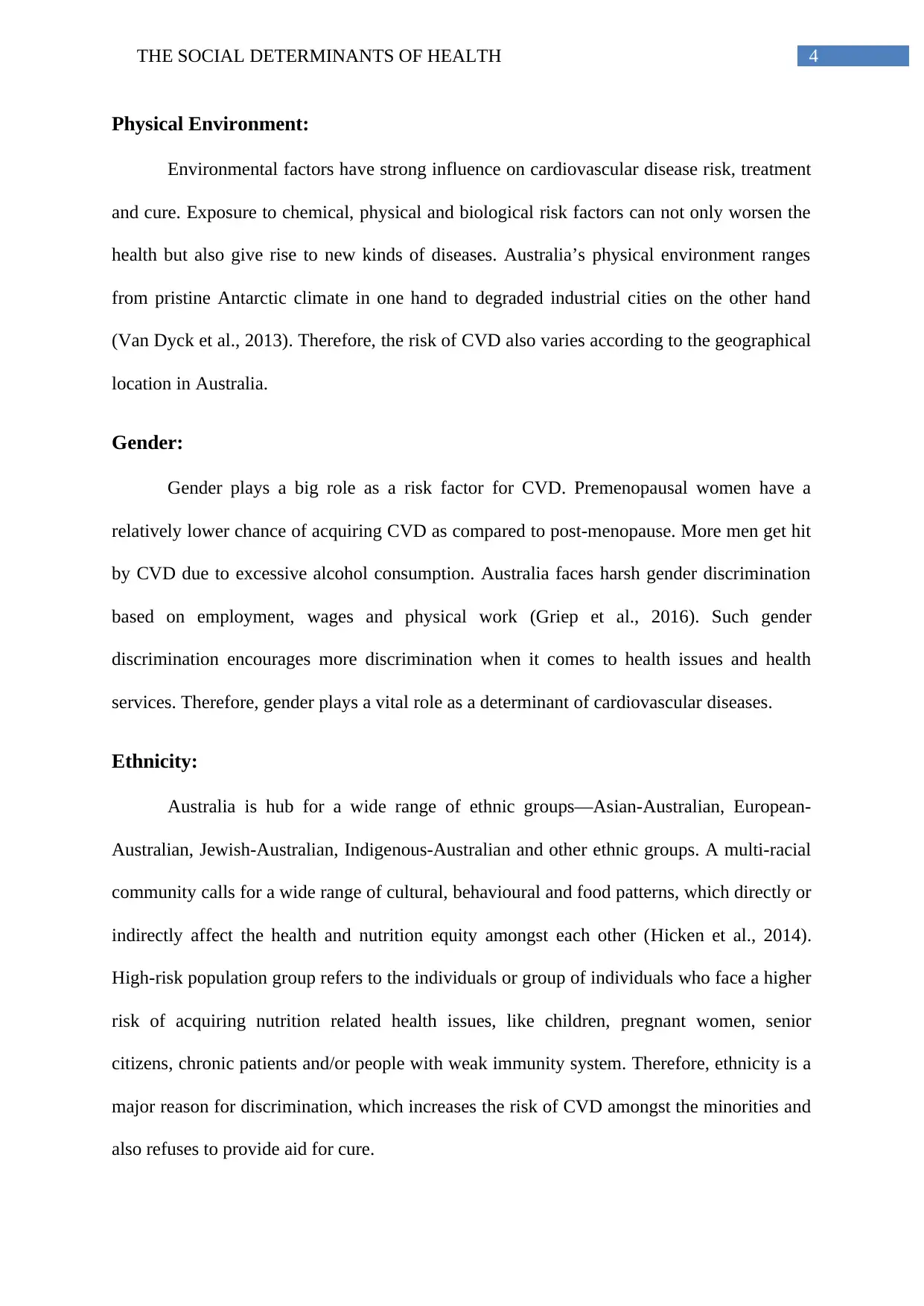
4THE SOCIAL DETERMINANTS OF HEALTH
Physical Environment:
Environmental factors have strong influence on cardiovascular disease risk, treatment
and cure. Exposure to chemical, physical and biological risk factors can not only worsen the
health but also give rise to new kinds of diseases. Australia’s physical environment ranges
from pristine Antarctic climate in one hand to degraded industrial cities on the other hand
(Van Dyck et al., 2013). Therefore, the risk of CVD also varies according to the geographical
location in Australia.
Gender:
Gender plays a big role as a risk factor for CVD. Premenopausal women have a
relatively lower chance of acquiring CVD as compared to post-menopause. More men get hit
by CVD due to excessive alcohol consumption. Australia faces harsh gender discrimination
based on employment, wages and physical work (Griep et al., 2016). Such gender
discrimination encourages more discrimination when it comes to health issues and health
services. Therefore, gender plays a vital role as a determinant of cardiovascular diseases.
Ethnicity:
Australia is hub for a wide range of ethnic groups—Asian-Australian, European-
Australian, Jewish-Australian, Indigenous-Australian and other ethnic groups. A multi-racial
community calls for a wide range of cultural, behavioural and food patterns, which directly or
indirectly affect the health and nutrition equity amongst each other (Hicken et al., 2014).
High-risk population group refers to the individuals or group of individuals who face a higher
risk of acquiring nutrition related health issues, like children, pregnant women, senior
citizens, chronic patients and/or people with weak immunity system. Therefore, ethnicity is a
major reason for discrimination, which increases the risk of CVD amongst the minorities and
also refuses to provide aid for cure.
Physical Environment:
Environmental factors have strong influence on cardiovascular disease risk, treatment
and cure. Exposure to chemical, physical and biological risk factors can not only worsen the
health but also give rise to new kinds of diseases. Australia’s physical environment ranges
from pristine Antarctic climate in one hand to degraded industrial cities on the other hand
(Van Dyck et al., 2013). Therefore, the risk of CVD also varies according to the geographical
location in Australia.
Gender:
Gender plays a big role as a risk factor for CVD. Premenopausal women have a
relatively lower chance of acquiring CVD as compared to post-menopause. More men get hit
by CVD due to excessive alcohol consumption. Australia faces harsh gender discrimination
based on employment, wages and physical work (Griep et al., 2016). Such gender
discrimination encourages more discrimination when it comes to health issues and health
services. Therefore, gender plays a vital role as a determinant of cardiovascular diseases.
Ethnicity:
Australia is hub for a wide range of ethnic groups—Asian-Australian, European-
Australian, Jewish-Australian, Indigenous-Australian and other ethnic groups. A multi-racial
community calls for a wide range of cultural, behavioural and food patterns, which directly or
indirectly affect the health and nutrition equity amongst each other (Hicken et al., 2014).
High-risk population group refers to the individuals or group of individuals who face a higher
risk of acquiring nutrition related health issues, like children, pregnant women, senior
citizens, chronic patients and/or people with weak immunity system. Therefore, ethnicity is a
major reason for discrimination, which increases the risk of CVD amongst the minorities and
also refuses to provide aid for cure.
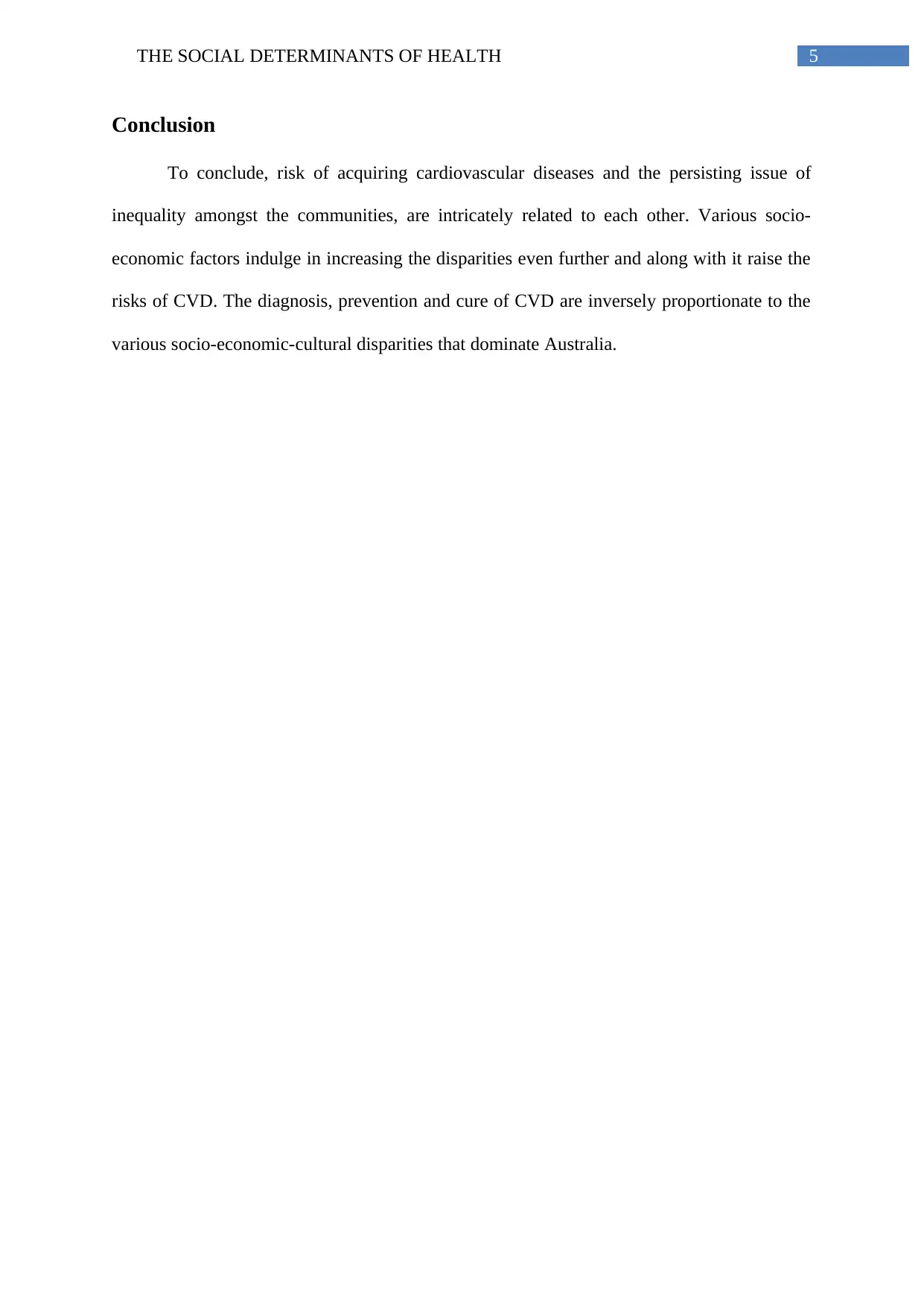
5THE SOCIAL DETERMINANTS OF HEALTH
Conclusion
To conclude, risk of acquiring cardiovascular diseases and the persisting issue of
inequality amongst the communities, are intricately related to each other. Various socio-
economic factors indulge in increasing the disparities even further and along with it raise the
risks of CVD. The diagnosis, prevention and cure of CVD are inversely proportionate to the
various socio-economic-cultural disparities that dominate Australia.
Conclusion
To conclude, risk of acquiring cardiovascular diseases and the persisting issue of
inequality amongst the communities, are intricately related to each other. Various socio-
economic factors indulge in increasing the disparities even further and along with it raise the
risks of CVD. The diagnosis, prevention and cure of CVD are inversely proportionate to the
various socio-economic-cultural disparities that dominate Australia.
⊘ This is a preview!⊘
Do you want full access?
Subscribe today to unlock all pages.

Trusted by 1+ million students worldwide
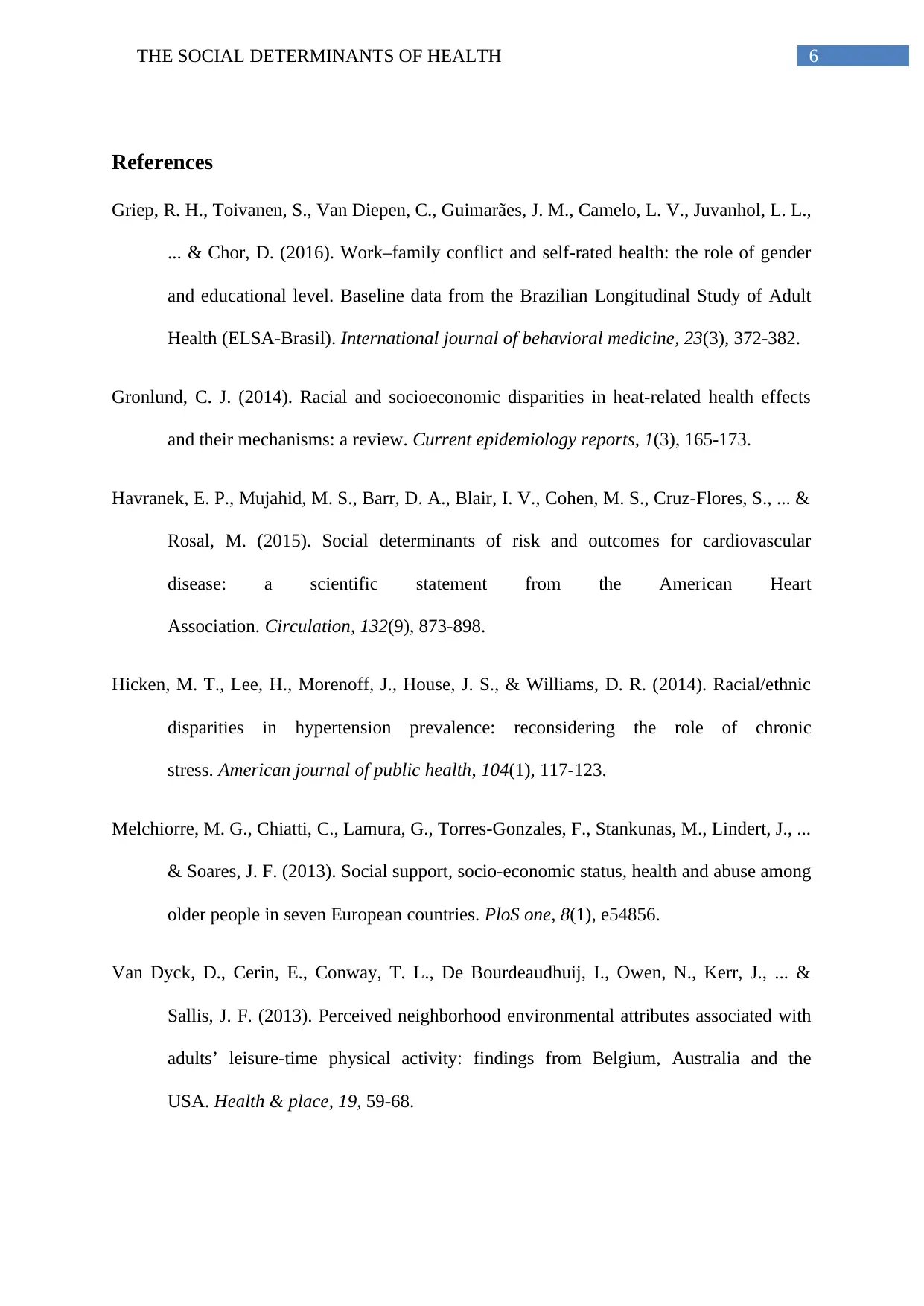
6THE SOCIAL DETERMINANTS OF HEALTH
References
Griep, R. H., Toivanen, S., Van Diepen, C., Guimarães, J. M., Camelo, L. V., Juvanhol, L. L.,
... & Chor, D. (2016). Work–family conflict and self-rated health: the role of gender
and educational level. Baseline data from the Brazilian Longitudinal Study of Adult
Health (ELSA-Brasil). International journal of behavioral medicine, 23(3), 372-382.
Gronlund, C. J. (2014). Racial and socioeconomic disparities in heat-related health effects
and their mechanisms: a review. Current epidemiology reports, 1(3), 165-173.
Havranek, E. P., Mujahid, M. S., Barr, D. A., Blair, I. V., Cohen, M. S., Cruz-Flores, S., ... &
Rosal, M. (2015). Social determinants of risk and outcomes for cardiovascular
disease: a scientific statement from the American Heart
Association. Circulation, 132(9), 873-898.
Hicken, M. T., Lee, H., Morenoff, J., House, J. S., & Williams, D. R. (2014). Racial/ethnic
disparities in hypertension prevalence: reconsidering the role of chronic
stress. American journal of public health, 104(1), 117-123.
Melchiorre, M. G., Chiatti, C., Lamura, G., Torres-Gonzales, F., Stankunas, M., Lindert, J., ...
& Soares, J. F. (2013). Social support, socio-economic status, health and abuse among
older people in seven European countries. PloS one, 8(1), e54856.
Van Dyck, D., Cerin, E., Conway, T. L., De Bourdeaudhuij, I., Owen, N., Kerr, J., ... &
Sallis, J. F. (2013). Perceived neighborhood environmental attributes associated with
adults’ leisure-time physical activity: findings from Belgium, Australia and the
USA. Health & place, 19, 59-68.
References
Griep, R. H., Toivanen, S., Van Diepen, C., Guimarães, J. M., Camelo, L. V., Juvanhol, L. L.,
... & Chor, D. (2016). Work–family conflict and self-rated health: the role of gender
and educational level. Baseline data from the Brazilian Longitudinal Study of Adult
Health (ELSA-Brasil). International journal of behavioral medicine, 23(3), 372-382.
Gronlund, C. J. (2014). Racial and socioeconomic disparities in heat-related health effects
and their mechanisms: a review. Current epidemiology reports, 1(3), 165-173.
Havranek, E. P., Mujahid, M. S., Barr, D. A., Blair, I. V., Cohen, M. S., Cruz-Flores, S., ... &
Rosal, M. (2015). Social determinants of risk and outcomes for cardiovascular
disease: a scientific statement from the American Heart
Association. Circulation, 132(9), 873-898.
Hicken, M. T., Lee, H., Morenoff, J., House, J. S., & Williams, D. R. (2014). Racial/ethnic
disparities in hypertension prevalence: reconsidering the role of chronic
stress. American journal of public health, 104(1), 117-123.
Melchiorre, M. G., Chiatti, C., Lamura, G., Torres-Gonzales, F., Stankunas, M., Lindert, J., ...
& Soares, J. F. (2013). Social support, socio-economic status, health and abuse among
older people in seven European countries. PloS one, 8(1), e54856.
Van Dyck, D., Cerin, E., Conway, T. L., De Bourdeaudhuij, I., Owen, N., Kerr, J., ... &
Sallis, J. F. (2013). Perceived neighborhood environmental attributes associated with
adults’ leisure-time physical activity: findings from Belgium, Australia and the
USA. Health & place, 19, 59-68.
Paraphrase This Document
Need a fresh take? Get an instant paraphrase of this document with our AI Paraphraser

7THE SOCIAL DETERMINANTS OF HEALTH
1 out of 8
Related Documents
Your All-in-One AI-Powered Toolkit for Academic Success.
+13062052269
info@desklib.com
Available 24*7 on WhatsApp / Email
![[object Object]](/_next/static/media/star-bottom.7253800d.svg)
Unlock your academic potential
Copyright © 2020–2025 A2Z Services. All Rights Reserved. Developed and managed by ZUCOL.





